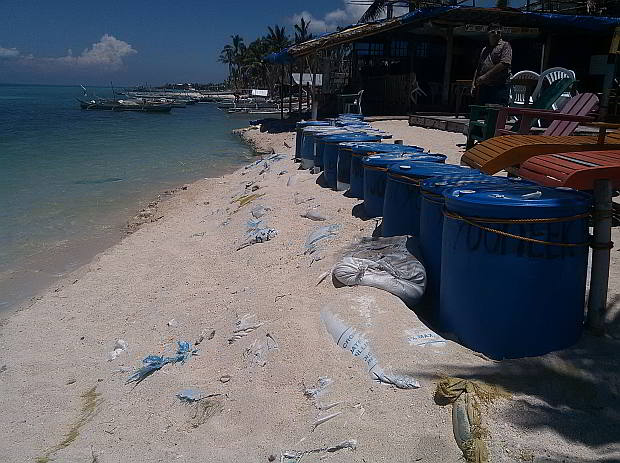DENR to check resorts in Sta. Fe, Bantayan as they’re too close to shore

Yoonek Beach Resort is at the doorstep of the sea in Sta. Fe town. A row of blue plastic barrels helps stop the erosion of beach sand and incoming waves. (CDN PHOTO/ PETER ROMANILLOS)
Several resorts in Sta.Fe , Bantayan Island are back in the shoreline, even those whose seawalls were demolished in 2010 by a court order for violating a 20-meter public easement.
This is already known by the Department of Environment and Natural Resources (DENR) 7, which handled the demolition four years ago.
“We will need more time because our office has not received a formal complaint about this situation. But we will get details so that we can further investigate,” said Al Orolfo, regional technical director of the Protected Areas and Wildlife Coastal Zone and Management Services of DENR.
He told Cebu Daily News he warned mayors of Bantayan Island’s three towns of Sta. Fe, Madridejos and Bantayan, not to build “permanent structures along the shoreline” especially after supertyphoon Yolanda wreaked havoc in Novvember 8 last year.
This reminder was made in a DENR seminar on enforcement of environment laws held in Sta. Fe three weeks ago.
The whole island is a protected area by virtue of two special laws, placing it’s land use under DENR regulations.
“For beach resorts, since they’re already there, we can serve them a notice disallowing them to further develop the property. But we will be strict about this. There should be no more permanent structures built in the shoreline,” added Orolfo.
“I told the three towns that they should really enforce the law on easements because they are the ones mandated by the law to implement.”
When Cebu Daily News visited Sta. Fe earlier this month, DENR-7 staff were conducting a seminar at a resort.
CDN’s walking tour of the town’s coastline showed several resorts rebuilding, including new concrete houses-for-rent along the shore.
At least three resorts, Marlin’s Beach Resort, Coral Blue Oriental Villas and Yooneek’s Resort, had extensions reaching out into the water or were located at the edge of the sea.
In front of Marlin’s, an elevated deck of beachsand atop piles of rubber tires serves as platform for picnic tables and umbrellas.
The sea is almost at the doorstep of Yoonek’s resort. Concrete structures demolished in 2010 are no longer visible. Blue plastic barrels are stacked in front, apparently to serve as a breakwater.
The situation is a sharp contrast to the Aug. 25, 2009 order of Mandaue City Regional Trial Court Judge Marilyn Yap, who ordered the demolition of illegal seashore structures of six beach resorts in Sta. Fe, including Marlin’s and Yooneek’s.
The order became final in May 12, 2010 and was carried out in May 27, 2010 by the DENR-7.
A crew used jackhammers and manual labor to enforce the decision, which was hailed as the “first judicial decision and interpretation of the Water Code of the Philippines.”
As a result of the order, no Environmental Compliance Certificate (ECC) has been issued by DENR since 2010 for new development projects in Bantyan.
Building permits
However, Sta. Fe municipal engineer Teodula Figuracion has been issuing several building permits to resort and house owners, old and new, on condition that their “ECCs will follow”.
The trend has disturbed the Sta. Fe Council, which called her attention.
Councilor Ithamar Espinosa told CDN they worry that fisherfolk will be unable to dock their boats if the shoreline gets too crowded and they lose access to the sea.
A popular tourist destination with its white sand beaches, Bantayan Island is covered by two special laws: Presidential Proclamation No. 2151 of 1981 declaring the island a protected area and Presidential Proclamation No. 1234 declaring Tañon Strait a protected seascape.
Impractical
A 40-meter “no build zone” announced by the national government after typhoon Yolanda was revised for being “downright impractical”, said Secretary Panfilo Lacson in Cebu the other day.
He said this could not be strictly enforced in areas that rely on fishing or tourism for economic recovery.
He said houses on stilts can be built but not “permanent structures”.
Lacson said the government would instead classify areas as “high risk”, “controlled” and “safe areas” through disaster-risk mapping.
The 2009 court decision in Cebu implements the Philippine Water Code, which establishes easement areas at specific distances from rivers or the sea to protect the right of the public to enjoy free access for fishing, navigation and floatage.
The distance is 3 meters in urban areas, 20 meters in agricultural areas (as in Bantayan’s case) and 40 meters in forest areas.
The case stemmed from a petition filed in 2008 by environment lawyers Antonio Oposa and Benjamin Cabrido “in behalf of the Bantayan Group of Islands.’
They sued for “for patrimonial malpractice” and secured an order barring the DENR from issuing any more ECCs to resorts and other applicants in Bantayan until a comprehensive land use policy is in place to guide further development.
Orolfo of DENR 7 confirmed that the agency has not issued a single ECC for projects in the island due to the continuing writ of mandamus issued by the Mandaue RTC four years ago.
But he said they can’t destroy any structures that encroach the easement zone without an order from the court.
“We cannot easily proceed with demolition without affording these owners due process. It has to follow legal procedure,” he said.
Related Stories:
Bantayan resorts build back on no-build zone for coastal families
‘No-build’ zone is ‘impractical’ – Lacson
Bantayan resorts build back on no-build zone for coastal families
Lacson wants Camotes, Bantayan relocation sites titled
Disclaimer: The comments uploaded on this site do not necessarily represent or reflect the views of management and owner of Cebudailynews. We reserve the right to exclude comments that we deem to be inconsistent with our editorial standards.
